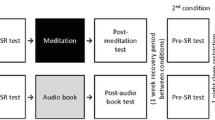Abstract
Vigilance, memory function, and response latency on the Sternberg short-term memory scanning task were examined in eight narcoleptic patients on and off medication. Off medication, half of the patients demonstrated reduced vigilance and all displayed diminished automatic memory encoding and longer response latencies on the Sternberg memory scanning procedure relative to the treated condition. Protriptyline normalized vigilance in half of the patients, while response latency and automatic information processing significantly improved in all. These findings are discussed with regard to the potential effect of the medication on central nervous system arousal.
Similar content being viewed by others
References
Aguirre M, Broughton R, Struss D (1985) Does memory impairment exist in narcolepsy-cataplexy? J Clin Exp Neuropsychol 7:14–24
Albert ML, Feldman RG, Willis AL (1974) The “subcortical dementia” of progressive supranuclear palsy. J Neurol Neurosurg Psychiatry 37:121–130
Battig WE, Montague WE (1969) Category norms for verbal items in 56 categories. A replication and extension of the Connecticut category norms. J Exp Psychol Monograph 80:1–46
Benton AL (1974) The revised visual retention test, 4th edn. Psychological Corporation, New York
Boehme RE, Baker TL, Mefford IN, Barchas JD, Dement W, Ciaranello RD (1984) Narcolepsy: cholinergic receptor changes in an animal model. Life Sci 19:1825–1828
Broughton R (1976) Discussion. In: Guilleminault C, Dement WC, Passouant P (eds) Narcolepsy. Spectrum Press, New York, pp 667
Broughton R, Ghanem Q, Hishikawa Y, Sugita Y, Nevsimalova S, Roth B (1983) Life effects of narcolepsy: relationships to geographic origin (North American, Asian, or European) and to other patient and illness variables. Can J Neurol Sci 10:100–104
Clark R, Boudoulas J, Schaal S, Schmidt H (1980) Adrenergic hyperactivity and cardiac abnormality in primary disorders of sleep. Neurology 30:113–119
Daly D, Yoss R (1957) The electroencephalogram in narcolepsy. Electroencephalogr Clin Neurophysiol 9:109–120
Delashaw JB, Foutz AS, Guilleminault C, Dement W (1979) Cholinergic mechanisms and cataplexy in dogs. Exp Neurol 66:745–757
Faull KF, Zeller-DeAmicus LC, Ruddle L, Bowersox S, Baker TL, Kilduff TS, Dement WC (1986) Biogenic amine concentrations in the brains of normal and narcoleptic canines: current status. Sleep 9:107–110
Foutz AS, Delashaw JB, Guilleminault C, Dement W (1981) Monoamine mechanism and experimental cataplexy. Ann Neurol 10:369–376
Hart RP, Henry GK, Kwentus JA, Leshner RT (1986) Information processing in children with Friedreichs Ataxia. Dev Med Child Neurol 28:310–313
Hasher L, Zacks RT (1984) Automatic processing of fundamental information. Am Psychol 39:1372–1388
Jones RE, Bobillier P, Pin C (1973) The effect of lesions of catecholamine-containing neurons upon monamine content of the brain and EEG and behavioral waking in the cat. Brain Res 58:157–177
Katkin ES (1976) Electrodermal lability: A psychophysiological analysis of individual differences in response to stress. In: Sarason IG, Spielberger CD (eds) Stress and anxiety. Wiley, New York, pp 141–176
Kilduff TS, Bowersox SS, Kaiting KI, Baker TL, Ciaranello RD, Dement WC (1986) Muscarinic cholinergic receptors and the canine model of narcolepsy. Sleep 9:102–106
Langdon N, Welch KI, Van Dam M, Vaughan RW, Parkes D (1984) Genetic markers in narcolepsy. Lancet II:8413
Levander S, Sachs C (1985) Vigilance performance and autonomic function in narcolepsy: effects of central stimulants. Psychophysiology 22:24–31
Lurkin K (1984) The neurobiology of the narcoleptic syndrome. Int J Neurosci 25:1–17
McNair D, Lorr M, Druppleman L (1981) Profile of mood states, 2nd Edn. Education and Industrial Testing Service, San Diego, California
Mitler M, Shafor R, Hajdukovich R, Timms R, Browman C (1986) Treatment of narcolepsy: objective studies on methylphenidate, pemoline, and protriptyline. Sleep 9:260–264
Okawa M, Matousek M, Peterson I (1984) Spontaneous vigilance fluctuations in the daytime. Psychophysiology 21:207–211
Rosvold H, Mirsky A, Sarason I, Bransome E, Beck I (1956) A continuous performance test of brain damage. J Consult Clin Psychol 20:343–350
Roth B (1957) L'activité de sommeil dans l'EEG comme indicateur d'une insuffisance chronique de l'éttat de vigilance. Electroencephalogr Clin Neurophysiol 7:309–311
Russell EW (1975) A multiple scoring for the assessment of complex memory functions. J Consult Clin Psychol 43:800–809
Sachs C, Kaijser L (1982) Autonomic regulation of cardiopulmonary functions in sleep apnea syndrome and narcolepsy. Sleep 5:227–238
Schmidt H, Clark R, Hyman R (1977) Protriptyline: an effective agent in the treatment of narcolepsy-cataplexy syndrome and hypersomnia. Am J Psychiatry 134:183–185
Sternberg S (1975) Memory scanning: new findings and current controversies. Q J Exp Psychol 27:1–32
Tilley A, Warren P (1983) Retrieval from semantic memory at different times of day. J Exp Psychol [Learn Mem Cogn] 9:718–724
Valley V, Broughton R (1981) Daytime performance deficits and physiological vigilance in untreated patients with narcolepsy-cataplexy compared to controls. Rev Electroencephalogr Neurophysiol Clin 1:133–139
Valley V, Broughton R (1983) The physiological (EEG) nature of drowsiness and its relation to performance deficits in narcoleptics. Electroencephalogr Clin Neurophysiol 55:243–251
Wechsler D (1945) A standardized memory scale for clinical use. J Psychol 19:87–95
Weingartner H, Grafman J, Boutelle W, Kaye W, Martin PR (1983) Forms of memory failure. Science 221:380–382
Weingartner H, Burns S, Diebel R, LeWitt P (1984) Cognitive impairments in Parkinson's Disease: distinguishing between effort-demanding and automatic cognitive processes. Psychiatry Res 11:223–235
Yoss RE (1969) Treatment of narcolepsy. Mod Treatment 6:1263–1274
Author information
Authors and Affiliations
Rights and permissions
About this article
Cite this article
Henry, G.K., Hart, R.P., Kwentus, J.A. et al. Effects of protriptyline on vigilance and information processing in narcolepsy. Psychopharmacology 95, 109–112 (1988). https://doi.org/10.1007/BF00212777
Received:
Revised:
Issue Date:
DOI: https://doi.org/10.1007/BF00212777




